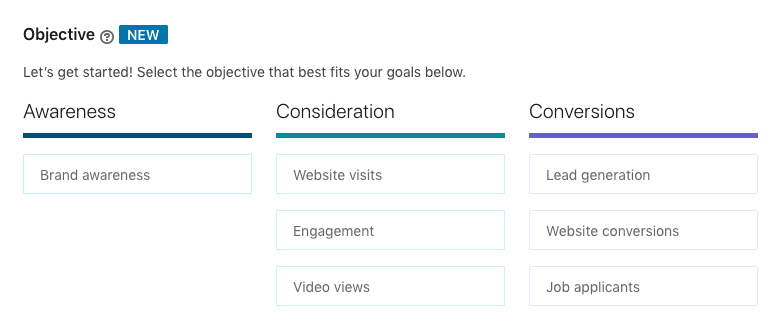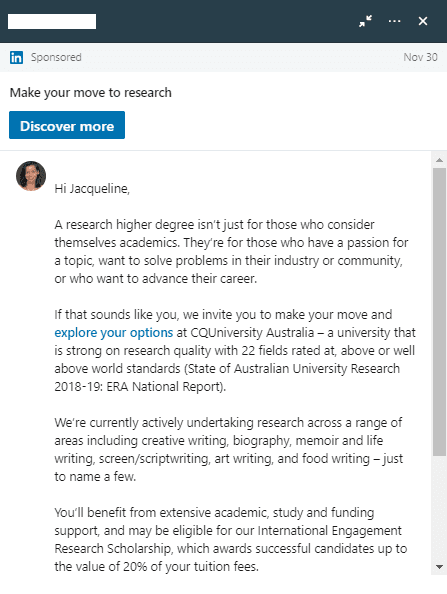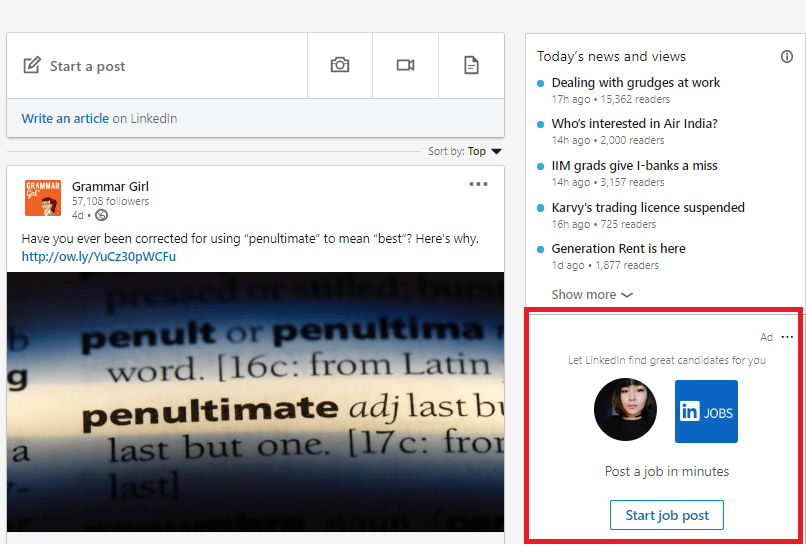The Pros and Cons of LinkedIn Ads
LinkedIn ads are among the most powerful advertising formats available to marketers in the B2B space. From awareness all the way to lead generation, LinkedIn has been proven effective (if you can afford them). This article will explore the strategic benefits and drawbacks and then provide you with a tactical implementation plan if you’re ready to get started.
The Pros of LinkedIn Ads:
- LinkedIn is the B2B holy grail. As a matter of fact, according to a study conducted by Grafton, an alarming 80 percent of B2B leads originate from LinkedIn.
- Account-based functionality. LinkedIn was built for enabling business-to-business commerce. That makes it the ideal platform for businesses to connect and engage with other businesses.
- Advanced targeting options. When you’re targeting a B2B market, certain audience variables, like job title/position become more important. LinkedIn enables you to narrow your market with advanced variables like location, job title, job function, seniority, company name, company size, industry, degree, skills, professional interests, and more.
- Personalization. Sponsored InMail is a great way to deliver customized messages directly to members of your target audience. This can be effective for inviting users to download gated content, inviting users to an event, or even motivating a purchase.
- Ad variety. LinkedIn offers a number of ad platforms, some of which are unique to the platform. The primary offerings include sponsored content, sponsored inmail, video ads, dynamic ads, carousel ads, and display ads. This variety allows LinkedIn to cater to the needs of almost every B2B marketer.
- The Lead Accelerator. LinkedIn goes beyond the first touchpoint by enabling users to track high-value prospects and deliver additional ads that can be customized for those high-profile accounts. It also has remarketing features that can be turned on based on recent website visitors and account lists.
- Industry-leading conversion rates. A year-long study by HubSpot found that LinkedIn ads more than triple the conversion rate of Google Ads. Where Google Ads customers can expect a conversion rate in the ballpark of 2.58 percent, HubSpot users experienced an average conversion rate of 9 percent on LinkedIn.
The Cons of LinkedIn ads:
- COST. LinkedIn ads are substantially more expensive when compared to other social ad platforms. For comparison, the average CPC of Google Ads has been reported at $3.35, while LinkedIn ads average $5.74.
- The spillover effect. In the B2B landscape, prospects are unlikely to engage with your brand on the first touchpoint. The result of this can be leads that originated on LinkedIn manifesting themselves in organic conversions. In other words, the prospect saw your ad on LinkedIn (maybe even clicked through), then they closed the tab—but got thinking about it later, so they started researching you on their mobile device and converted from that second touchpoint.
- Limited reporting and analytics. Where the Facebook Ads Manager can offer industry-leading insights, LinkedIn’s Campaign Manager is limited in comparison.
- Bumpy user experience. LinkedIn Campaign Manager is getting better with every update, but the user experience remains somewhat bumpy, with glitches being a regular part of the ad setup experience.
How to launch a LinkedIn ad campaign
1. Start by identifying your unique selling proposition (USP)
Use the tactics outlined in section 1 of this Facebook Ads article to help you isolate your USP.
2. Choose your ad objective
First things first, choose your ad objective. Being that most B2B leads aren’t as willing to convert on lead ads, we’ve often found that a “Website visits” objective can be as effective or more effective than other conversion objectives.

3. Find your audience
There are a couple of ways to isolate your audience on LinkedIn. Firstly, you can use the tools and segmentation variables that are built into the Campaign Manager to target prospective customers. Secondly, you can create custom audiences leveraging lookalike and audience expansion style strategies. And lastly, you can upload a list to target specific LinkedIn accounts/companies. For an expansion on the list approach, visit section 3 under Account-Based Tactics and Strategies.
Here’s how to build an audience on LinkedIn:
- Start by defining your audience location (the only mandatory targeting parameter on LinkedIn). Get specific or keep it broad.
- Build your audience based on optional variables
- Company: connections, followers, industry, name, size.
- Demographics: age and gender.
- Education: degrees, fields of study, member schools.
- Job experience: function, seniority, title, skills, years of experience.
- Interests: groups and member interests
- Ensure that your target audience estimates remain over 50,000 for sponsored content and text ads, and over 15,000 for message ads.
- Consider A/B testing your audiences. This can be done by duplicating your campaign and slightly altering your audience parameters.
Note: LinkedIn also has audience templates available if it’s your first time creating an audience.
Here are a couple of ways to use AI to create custom targeting on LinkedIn:
- Enable audience expansion as you build your audience. This feature will automatically identify additional audience members that are similar to your specified target audience, and add them to your campaign. This is best used when targeting specific facets where there is a risk of missing members, such as job titles, skills, groups, etc.
- Create lookalike audiences. Lookalike audiences behave much in the same way but are best used when looking to hone in on specific audience variables through a lead generation campaign objective.
- Use the matched audiences’ features. This allows you to coordinate your LinkedIn targeting with other business data, like re-engaging website visitors or nurturing existing prospects.
4. Determine your ad format
LinkedIn offers three ad formats that can all be effective if paired with the right content and the right audience. The three choices include sponsored posts, message ads, and dynamic ads. Your choice in ad format will also serve to help you identify your CTA (and vice versa).
Sponsored content appears in the newsfeed and resembles an organic post with the exception of a “Promoted” designation and a CTA button.

Benefits to sponsored posts:
- The most organic ad format as it appears in-line with other organic content.
- Users are conditioned to consume ad content in the newsfeed.
- Image, carousels, and videos can all be used as the primary ad content.
Message ads are ads that are delivered via LinkedIn InMail. They are delivered in a similar fashion that a DM to a connection would be, but they are accompanied by a sponsored designation.

Benefits to message ads:
- Greater personalization. InMail messages behave a lot like email in the ways that they allow advertisers to personalize their messaging with variable tags, like company tags, and more.
- More content. Sponsored and dynamic ads are both limited in the volume of content that can be used, but InMail messages offer a lot more room for elaboration.
- Great for niche markets and hyper-targeted audiences.
Text and dynamic ads are banners that appear on the side carousels of various LinkedIn pages. These are a little different than your standard banner ad, however, as they allow marketers to personalize them to address users by name and profile picture.

Benefits to text and dynamic ads:
- Great for company spotlight based ads, content ads, or job posting ads.
- Great for generating awareness when paired with other LinkedIn ad formats.
5. Create your visuals
Depending on your chosen ad format(s), you will want to either create graphics or video content. These are general insights to help guide your content creation, but the reality is that the only way to know for sure what will perform best for your brand is to test both formats with different messaging against different audiences.
Here are some tips for LinkedIn ad graphics
- Ensure that sponsored images are 1200×627 and that carousel images are 1080×1080.
- Keep it real. Authenticity reigns supreme on LinkedIn, so integrating photography is always a good idea. Faces are powerful, but product pictures can also be powerful depending on the industry in which you reside.
- Overlay text that supports your offer. There are few cases when using some text on an image ad is not a good idea. The graphic is the first piece of your ad to garner audience attention, so presenting your offering or key details in the image can be a great way to drive further action.
- Consider adding a “button” to the image. Adding a graphical button is a great way to boost performance by giving your audience another place to convert.
Here are some tips for LinkedIn ad videos:
- Ensure that videos also meet either the 1200×627 or 1080×1080 dimensions.
- Use a “Video views” ad objective if you are simply trying to generate awareness. Otherwise, a lead generation objective will still be effective for driving conversions with video content.
- Add captions so that the video makes sense without audio being that most users have autoplay audio turned off by default.
- Include a clear CTA in the video as well as the ad copy so that there is no confusion surrounding the action that you are trying to elicit.
6. Write your ads
It’s important that you always start every LinkedIn campaign with four ad variants. This gives you a chance to test different graphics, different text, and different CTAs while also optimizing your ad rotation (LinkedIn rotates four ads per day). It’s best practice to do a two-image/video, two-text split so that you can determine the best performing combinations before you introduce new challenger ads.
Here is an example of a Vendasta competitive campaign that’s queued for launch:

Pro-tip: If you are running blog ads, try removing the CTA button entirely so that the ad looks organic when it appears in the newsfeed. We were able to increase our click-through rate by more than 300 percent when we used this trick on a batch of radio ads that we ran.
7. Optimize, optimize, optimize
After your campaign has been running for some time and has generated leads, clicks, or otherwise, then you can begin to tweak your ads to optimize your performance.
Here’s how to best optimize your ad performance:
- Eliminate the worst performers. Certain ad variants are going to outperform others, and it’s your job to eliminate the ads that aren’t living up to expectations. However, when you turn one variant off, you should always create a challenger ad that is crafted in the image of one of your top performers. You should continue this process of turning off ads and creating challengers for a few weeks until you’ve identified clear champions.
- Tweak audience variables. Once your ads have begun achieving your desired results, you will be able to gain new insights through the demographics function. Once inside your campaign, if you click on demographics near the top, LinkedIn will provide you with detailed information on the professionals that have clicked and converted on your ads. These insights can help you adjust both your content and your audience segmentation.
- Inject new media content into top performers. After a few months, even top-performing content needs a refresh, otherwise, you run the risk of creating ad fatigue and experiencing performance drop-off.
